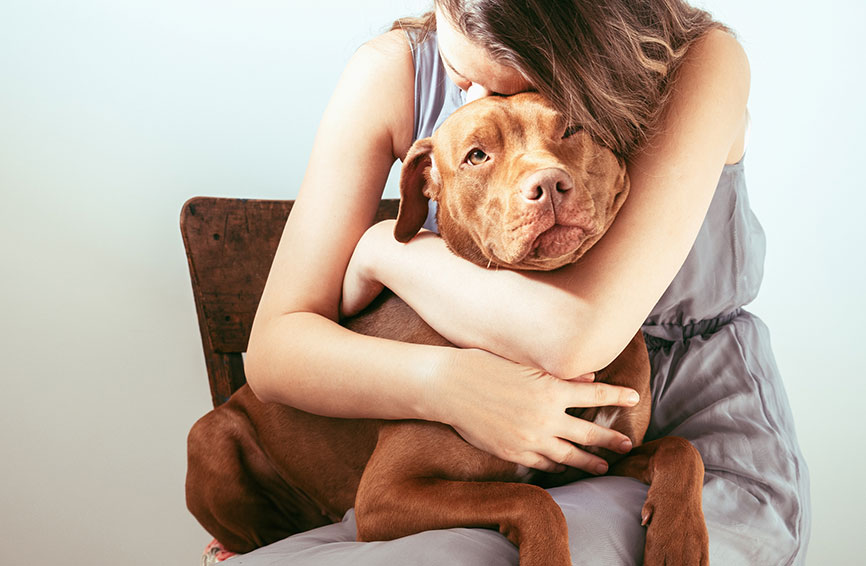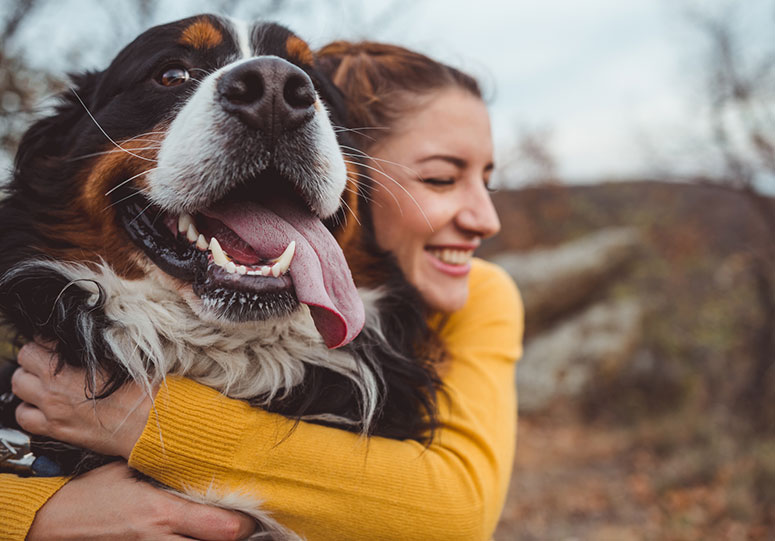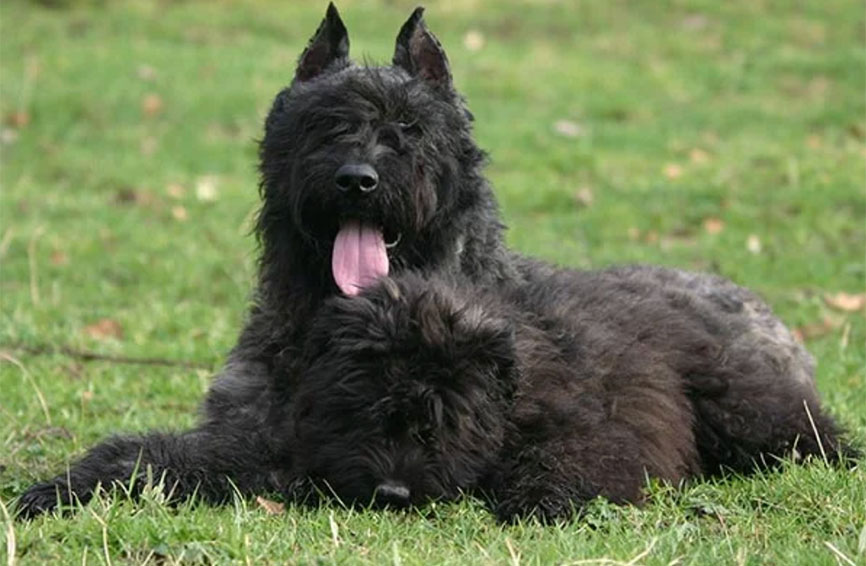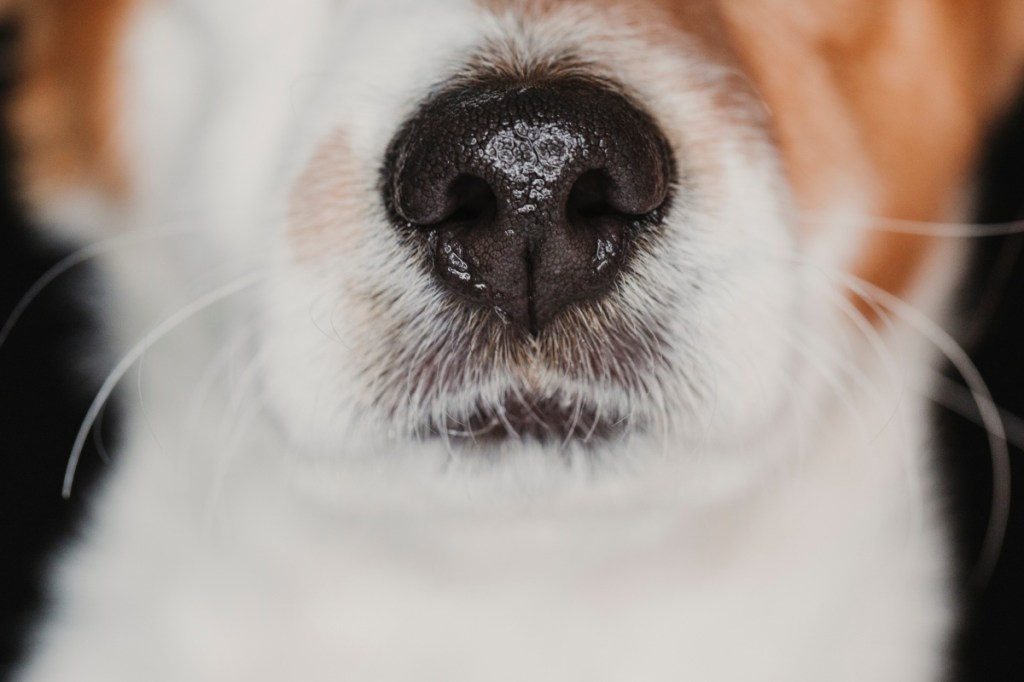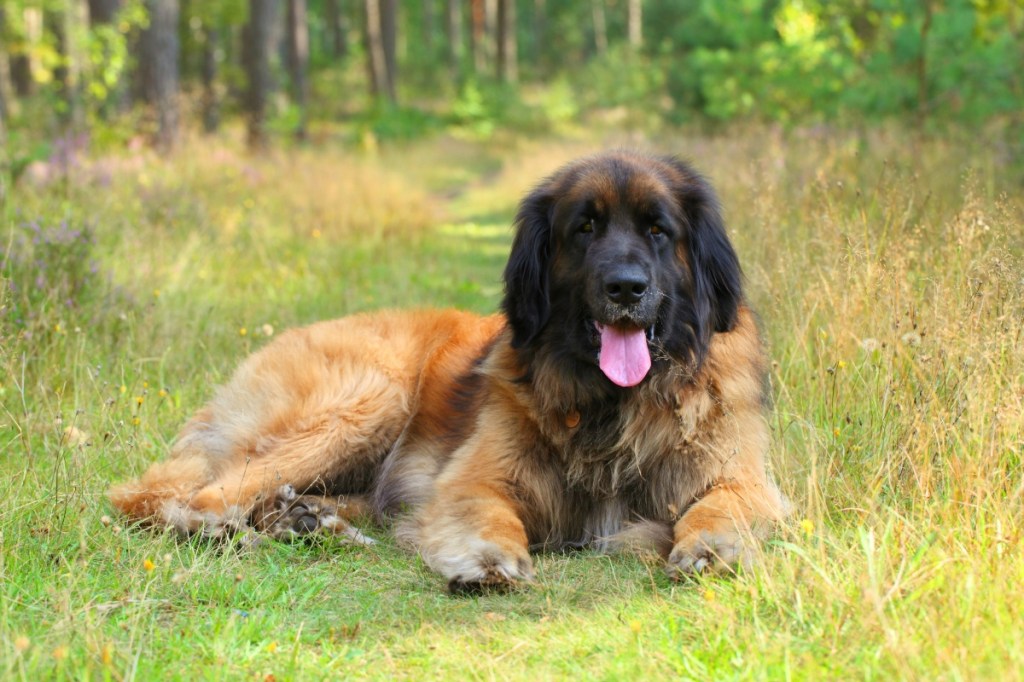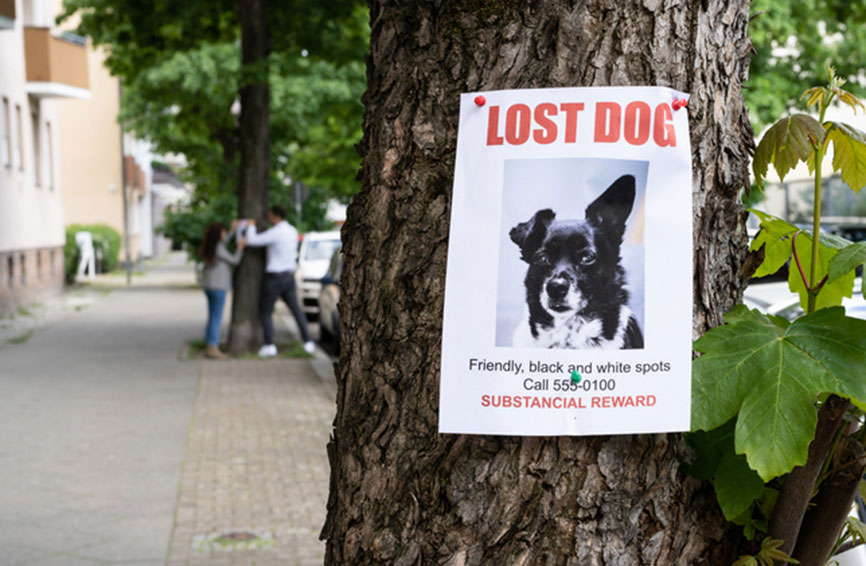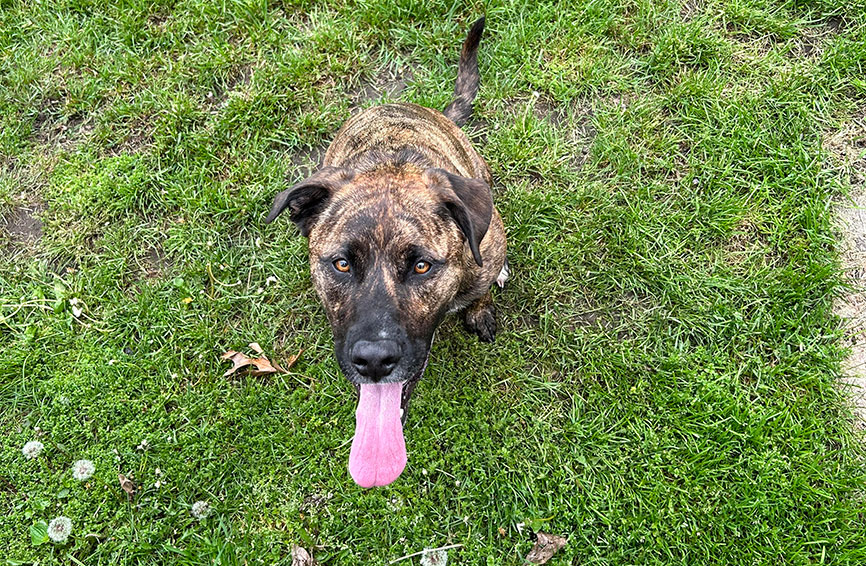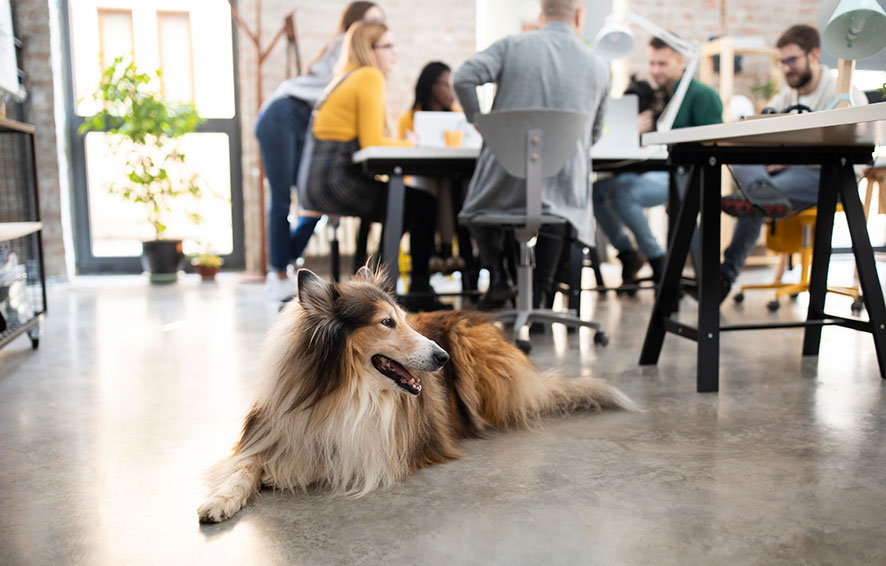Key Takeaways
- Many people try to show affection to their dogs by hugging them, but almost all dogs dislike being held.
- It’s essential to be able to read your dog’s body language and stop embracing them if they show signs of anxiety.
- You may be able to help a dog become more tolerant of hugs as a safety measure in case a stranger tries to hug them.
Table of Contents
As humans, it is natural to want to shower love and affection on the dogs we share our lives with, and the media often portrays idealized versions of this human-animal bond with pet parents bear-hugging their furry friends.
While some dogs indeed enjoy physical affection, dogs differ widely in how much they are willing to tolerate, and some might find being confined, cuddled, or hugged to be more uncomfortable than welcomed. Even dogs who enjoy being petted or having their bellies rubbed may find the tight embrace of a hug a bridge too far or at best, don’t always want physical touch. Some may even find it threatening and could bite in response. Just because a dog chooses to be near you (even on your lap) that does not necessarily mean he wants to be touched, let alone hugged. Dog often enjoy proximity to us but are not looking for physical contact.
One dog expert estimates that almost all dogs (82 percent) dislike hugs, and immobilizing them causes stress or discomfort. Dr. Stanley Coren looked at 250 photos of dogs being hugged and concluded that 204 of the dogs in the photos showed signs of being uncomfortable, such as looking away or ears turned down.
It’s essential to know your dog or be able to read signals that a dog may be giving off that indicate whether they are comfortable with being touched and how much. You can then advocate for your dog when strangers approach. Especially when it comes to children, forcing affection on a dog who doesn’t care for it can be unsafe.
Dogs are not people
Many people assume that dogs like affection the same way people do. But if you watch dogs interact, you’ll notice they don’t embrace each other. They might wrestle and pin each other down, but this is in the context of play fighting or real fighting, the American Kennel Club says.
Dogs are social animals who rely on their pack for safety and survival. As such, they use a complex body language and communication system to signal their intentions, emotions, and boundaries to other dogs.
Humans are not always skilled at reading these signals, leading to misunderstandings and conflict. When someone hugs a dog, it can feel trapped and vulnerable. In the wild, dogs had to be able to move and escape if they felt threatened or uncomfortable. When a hug takes away that ability, it can trigger feelings of anxiety.
Factors that influence your dog’s comfort level with affection
Dogs are individuals, and factors such as breed, history, and temperament will determine how much physical affection they like. Dogs who are socialized when they are young and treated well by humans throughout their lives will likely be more welcoming of physical touch.
Some breeds are known to be extra cuddly – Golden Retrievers, Labrador Retrievers, cocker spaniels, American Staffordshire bull terriers (pit bulls), and Australian Shepherds are known for their gregarious nature. Other breeds are known to be more reserved, such as cane corso, Cairn terrier, Shiba Inu, and mastiffs. Of course, these are generalizations and may not apply to individual dogs.
A dog with a traumatic past, especially if they have been abused, homeless, or spent a lot of time in various homes or shelters, is naturally going to be more cautious around people, at least at first. Some may learn to warm up to family members and strangers, while others may remain reserved throughout their lives. Pet parents need to recognize their dog’s needs and limitations and adjust their behavior accordingly.
Signs your dog likes hugs
A dog who is enjoying a hug will be relaxed and at ease. They will not be showing any of the stress signals listed below.
The Pat-Pet-Pause method of determining consent
- PAT your legs to see if the dog comes to you. If they do not, do not approach! We are allowing the dog to initiate the interaction. If the dog comes to you, proceed to…
- PET the dog’s back, side, chest (not going over the top of her head) for 2-4 seconds with one hand (not both) then…
- PAUSE (hands off!)See what the dog does next. Do they come in for more or shake off and walk away?
- If they stay with you (assuming she could move away) continue to pet for a few seconds and then STOP petting to allow the dog the ability to opt out of the interaction.
Other consent resources from Danette Johnston
Signs your dog is uncomfortable with hugs
Some dogs will make it clear that they are unhappy with hugs by growling, snarling, or even biting. However, not all dogs are so obvious. Here are some more subtle signs to look for:
- Turning their head away
- Licking their lips or nose
- Yawning
- Stiffening their body
- Trying to move away
- Whining or whimpering
- Ears going backward
- Mouth going from open and relaxed to closed.
If you see any of these signs, respect your dog’s boundaries and stop touching them.
Teach your dog to tolerate hugs
While most dogs do not enjoy hugs, many can learn to tolerate them. For safety and to help prepare your dog for unexpected hugs from well-meaning strangers or children, teach them to put up with being hugged, even if they don’t like it. If a stranger approaches your dog and tries to embrace them, gently discourage it and suggest a scratch on the neck, under the ears or on your dog’s rump instead (if your dog is OK with this).
You can change your dog’s negative association with hugs using desensitization and counter-conditioning training techniques. Here are a few tips from the AKC:
- Start by pairing gentle petting with treats or another reward, then slowly increase the invasiveness until you are gently restraining your dog.
- Increase the firmness of your embrace, all while continuing to reward your dog after each hug.
- Pay attention to your dog’s body language. If they show any signs of discomfort or anxiety, stop the hug and return to petting.
- Repeat this regularly, and in time, your dog will put up with an awkward embrace for the chance to earn a reward.
Ways to show your dog affection besides hugs
While hugs may not be the best way to show your dog affection, there are plenty of other ways to bond with your furry friend. Even if they don’t like being confined in an embrace, most dogs enjoy other types of touching.
- Pet them or give belly rubs: Touch your dog in a way that is comfortable and enjoyable for them.
- Play games: Dogs love to play, so spend some time each day playing fetch, tug-of-war, or hide-and-seek.
- Go for walks: Walking your dog is essential physical and mental exercise and a perfect way to bond and explore the world together.
- Give them a massage: Just like humans, dogs can benefit from a gentle massage to help them relax and feel good.
- Talk to them: Dogs love the sound of their owner’s voice, so spend some time each day talking to your dog and telling them how much you love them.
- Give treats: Almost all dogs love treats. To avoid overfeeding your dog, keep track of the caloric amount of the treats and adjust meal sizes. Dispense treats primarily as a reward for good behavior or teaching new skills.
In conclusion, while a few dogs may enjoy hugs, most do not. You can build a strong and healthy bond with your four-legged friend by paying attention to your dog’s body language and respecting their boundaries. And if your dog doesn’t like hugs, don’t worry – there are plenty of other ways to show them affection and make them feel loved.
